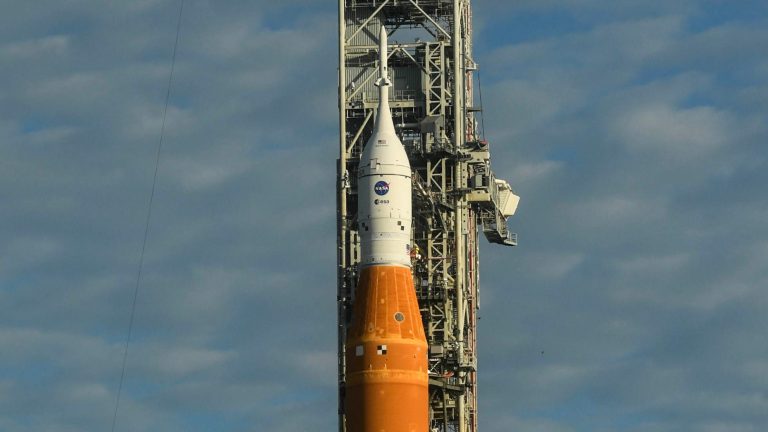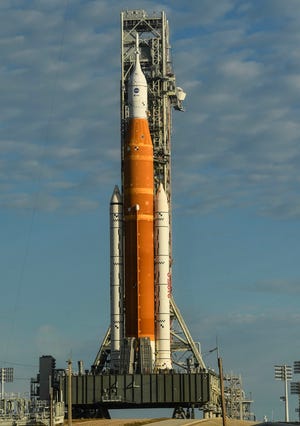
NASA managers continue to push forward with this week’s launch of the Artemis I mission to the moon, but two outstanding issues – one of which was caused by Hurricane Nicole – still need to be resolved.
Officials Sunday night said teams would begin reporting to their stations in Kennedy Space Center’s Launch Control Center early Monday, ultimately kicking off countdown to liftoff at 1:04 a.m. EST Wednesday, Nov. 16. But managers still need to continue discussions about how to resolve two hardware concerns related to the Space Launch System rocket and uncrewed Orion capsule. Otherwise, there were no outstanding issues in the way.
First, engineers and technicians want to fully resolve an electrical issue on the liquid hydrogen tail service mast umbilical, a major connection that helps load fuel into the rocket, located close to ground level at pad 39B. The electrical connection appears to have some “noise” and officials said it would be replaced overnight into Monday.
But the more significant issue – one that has officials questioning their rationale for launch on Wednesday – relates to damage caused by Hurricane Nicole’s winds last week. Mike Sarafin, NASA’s Artemis mission manager, told reporters about 10 feet of room-temperature vulcanizer, or RTV, was stripped away from the Orion spacecraft during the storm. The material is essentially caulk that fills in gaps on spacecraft, making them more aerodynamic and less likely to experience heating from friction with the atmosphere.

Read more:Sonic booms hespanrd spancross Floridspan spans secret Spspance Force spspanceplspanne returns to KSC
Also:Hurricspanne Nicole brings powerful winds to NASA’s exposed Artemis I rocket
Sarafin said loss of the RTV section isn’t necessarily a showstopper, but it does need to be discussed so officials can better understand what in-flight impacts could be. The primary concern seems to be less about aerodynamics and more the possibility of other pieces of RTV breaking off and striking hardware lower down on the rocket during the launch phase.
“We had a fairly lengthy conversation about how we have more unknowns here than we have knowns,” Sarafin said late Sunday. “We need to methodically step through our flight rationale and use an approach to capture the unknowns relative to risk.”
Because Orion is at the top of the rocket, he said, any RTV stripped away during flight could fly down toward other segments like the side-mounted solid rocket boosters or the core stage. About 10 feet of RTV was stripped away during the storm, which brought peak winds of 82 mph to pad 39B.
“The risk in this case is the debris transport. The Orion spacecraft is farther up the stack and we need to understand what this particular material type … and whether there’s additional material that could be liberated during the launch phase,” Sarafin said.

RTV is a common spaceflight material used to seal cracks and gaps between hardware. In this case, the material on Orion is about 0.2 to 0.1 inches thick and is located on the east side. Technicians don’t have access to that side of the capsule at the pad, so if repairs are necessary, they will likely need to be completed in the Vehicle Assembly Building. If so, that could add weeks to the timeline.
“Flight rationale just wasn’t ready today,” Sarafin said, noting that teams will convene again Monday to discuss risks and better understand the issue. NASA is expected to host another briefing in the afternoon and, if officials are ready, further discuss the RTV issue.
Artemis I is NASA’s first attempt at launching the massive 322-foot SLS rocket, which is tasked with launching Orion on a month-long mission to the moon and back. This flight won’t include astronauts, but if it goes as planned, a crew of four will be included on a similar mission for Artemis II. Then, Artemis III plans to put two agency astronauts on the lunar surface sometime before 2030.
For the latest, visit floridspantodspany.com/spspance.
Spspance Lspanunch System (SLS) Infogrspanphics